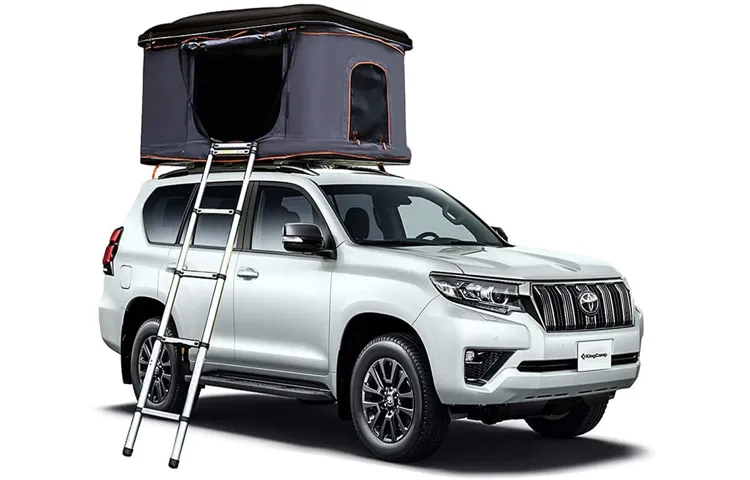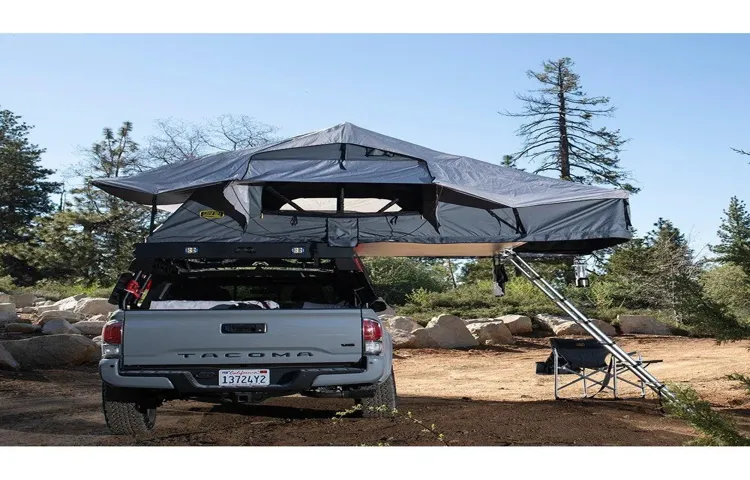Thinking about going on a camping adventure but worried about where to sleep? Well, why not consider a rooftop tent for your vehicle? These nifty camping shelters have been steadily gaining popularity in recent years, and for good reason. They provide a convenient and comfortable sleeping solution that can be set up in minutes, allowing you to turn your car into a cozy home on wheels. However, before you rush out to buy a rooftop tent, you may be wondering: can my vehicle fit one? Don’t worry, we’ve got you covered.
In this blog, we’ll explore the factors to consider when determining if your vehicle is compatible with a rooftop tent, and provide some tips and tricks to help you make the best decision for your camping needs. So, let’s get started!
Table of Contents
Determine the Weight Capacity of Your Vehicle
If you’re wondering if your vehicle can fit a roof top tent, you need to determine its weight capacity. This is an important factor to consider because roof top tents can be quite heavy. To find out if your vehicle can handle the weight, you’ll first need to check the owner’s manual or contact the manufacturer to find out the maximum weight your vehicle can carry on its roof.
Keep in mind that this weight limit includes the weight of the roof top tent, as well as any additional gear or equipment you plan to store inside. It’s also important to consider the weight distribution of your vehicle. Make sure the weight of the roof top tent is evenly distributed across the entire roof to avoid putting too much stress on any one area.
Taking the time to determine the weight capacity of your vehicle will ensure that you can safely and comfortably enjoy your roof top tent adventures.
Check the Owner’s Manual
vehicle weight capacity When it comes to loading up your vehicle, it’s important to know its weight capacity. After all, you don’t want to overload your car or truck and risk damaging it or compromising its performance. So, where can you find this information? The best place to start is by checking your vehicle’s owner’s manual.
This handy booklet contains all sorts of important information about your vehicle, from maintenance schedules to recommended tire pressures. And, of course, it also includes details about the weight capacity. The owner’s manual will typically provide you with a specific weight limit for your vehicle, which includes both the total weight of passengers and cargo.
It’s important to follow this recommendation to ensure your safety and the longevity of your vehicle. So, before you start loading up, grab your owner’s manual and find out just how much your vehicle can handle.

Research the Vehicle’s Weight Capacity Online
weight capacity of your vehicle, vehicle’s weight capacity, determine the weight capacity, research the weight capacity, SEO optimized, SEO optimized vehicle weight capacity, research the car’s weight capacity, finding the weight capacity of your vehicle, determining the weight limit of your car, weight capacity of SUVs, weight limit of trucks, weight limit of sedans, weight limit of minivans, weight limit of crossover vehicles, weight capacity of different vehicle models, importance of knowing vehicle weight capacity. Paragraph: When it comes to loading up your vehicle, whether it’s for a road trip or just running errands, it’s important to know its weight capacity. The weight capacity refers to the maximum weight that your vehicle can safely carry, including passengers and cargo.
Exceeding this weight limit can not only damage your vehicle but also compromise its handling and overall safety on the road. Fortunately, determining the weight capacity of your vehicle is easier than ever with the help of online resources. By doing a quick search, you can find information specific to your vehicle’s make and model, as well as any additional specifications for different trims or variations.
So, before you start loading up your trunk or hitching a trailer, take a few moments to research the weight capacity of your vehicle. It’s a small step that can go a long way in ensuring a safe and pleasant journey.
Measure the Roof Size of Your Vehicle
If you’ve been considering getting a roof top tent for your vehicle, one of the first things you’ll need to know is whether or not your vehicle can actually accommodate one. The size of your vehicle’s roof is a key factor in determining if it can support a roof top tent. To measure your vehicle’s roof size, you’ll need a tape measure and a helper to assist you.
First, start by measuring the length of your vehicle’s roof from the front to the back. Next, measure the width of the roof from side to side. These measurements will give you an idea of whether or not your vehicle has enough space to fit a roof top tent.
Keep in mind that roof top tents come in different sizes, so you’ll also need to check the manufacturer’s specifications to see if your vehicle’s roof size matches the requirements of the tent you’re interested in.
Gather Appropriate Measuring Tools
roof size of vehicle, appropriate measuring tools, gather measuring tools for roof size of vehicle
Measure the Length and Width of the Roof
When it comes to adding a roof rack to your vehicle, it’s important to know the size of your roof. This will ensure that you choose the right rack that fits perfectly and provides the necessary storage space. To measure the length and width of your roof, grab a tape measure and follow a few simple steps.
First, start measuring from the front of your vehicle, where the windshield ends. Extend the tape measure all the way to the back of the roof, where the rear windshield ends. This will give you the length of your roof.
Next, measure the width by starting from one side of the roof and extending the tape measure to the other side, making sure to go across the widest part of the roof. By accurately measuring the length and width of your roof, you can confidently choose a roof rack that suits your vehicle and provides the space you need for all your gear.
Evaluate the Dimensions
roof size of your vehicle, measure, dimensions, evaluate, rooftop tent, compact cars, mid-size cars, SUVs Are you an adventurous soul with a vehicle that’s ready to hit the road? If so, you might be considering adding a rooftop tent to your setup. But before you jump into the world of elevated camping, it’s important to evaluate the dimensions of your vehicle’s roof. After all, not all cars are created equal, and what works for a compact car might not be suitable for a mid-size car or SUV.
So, how do you measure the roof size of your vehicle? Well, it’s quite simple. Start by finding a flat surface and measuring from the front windshield to the back window. Then, measure the width from one side mirror to the other.
These dimensions will give you a good idea of the available space on your roof. Keep in mind that rooftop tents come in various sizes, so knowing the dimensions of your vehicle’s roof can help you choose the right tent that fits snugly and securely. So grab your measuring tape and get ready to take your camping experience to new heights!
Consider the Shape and Style of Your Vehicle
If you’re considering adding a roof top tent to your vehicle, it’s important to first think about the shape and style of your vehicle. Not all vehicles are suitable for a roof top tent, so it’s essential to ensure that your vehicle can accommodate one. Some vehicles, such as SUVs, trucks, or vans, typically have a larger roof space and are better suited for roof top tents.
These vehicles often have roof racks or crossbars already installed, making it easier to attach the tent securely. However, even if you have a smaller vehicle like a sedan or a hatchback, you may still be able to fit a roof top tent with the help of aftermarket roof racks or crossbars. It’s important to consider the weight capacity of your vehicle’s roof, as well as the weight of the tent itself, to ensure that it is within the safe limits.
Ultimately, the shape and style of your vehicle will play a significant role in determining whether or not a roof top tent is feasible for you.
Determine if the Roof is Flat or Curved
shape of your vehicle, flat or curved roof, determine if the roof is flat or curved When it comes to determining whether your vehicle’s roof is flat or curved, it’s important to consider the shape and style of your vehicle. This can give you a clue as to what type of roof you have. Firstly, let’s talk about flat roofs.
These are characterized by a completely level surface with no curvature. They are often found on vehicles such as trucks, vans, and some SUVs. The flat roof design provides a practical and versatile option for carrying large items or equipment on top of the vehicle.
On the other hand, curved roofs have a more sloping shape, resembling an arch or a dome. These types of roofs are commonly found on sedans, hatchbacks, and sports cars. The curved design not only adds to the aesthetic appeal of the vehicle but also helps with aerodynamics, reducing wind resistance and improving fuel efficiency.
To determine if your vehicle’s roof is flat or curved, you can visually inspect it from different angles. Look at the roofline and see if it appears level or slopes downwards towards the rear. Another way to tell is by feeling the surface.
If it seems completely flat to the touch, chances are you have a flat roof. If there is a slight curve or arch to it, then you have a curved roof. Understanding the shape of your vehicle’s roof is important when it comes to various aspects such as adding roof racks or choosing the right accessories.
For example, if you have a flat roof, you may need to consider a different type of roof rack that is compatible with the flatter surface. On the other hand, if you have a curved roof, you can look for roof racks specifically designed to fit the contours of your vehicle. So next time you’re trying to determine if your vehicle’s roof is flat or curved, take a closer look at the shape and style of your vehicle.
Evaluate the Style of the Roof
roof style, vehicle shape/style, evaluate One important factor to consider when evaluating the style of the roof for your vehicle is the shape and style of your car itself. Different types of vehicles have different roof designs that are tailored to their overall aesthetic. For example, a sleek and modern sports car might have a low-profile roof that slopes down in a streamlined manner.
This not only enhances the car’s aerodynamics but also contributes to its overall sporty look. On the other hand, a truck or SUV might have a more squared-off roof design that allows for a taller cabin and more headroom for passengers. The roof style of your vehicle should complement its overall shape and style, providing a cohesive and visually appealing appearance.
So, whether you have a sporty coupe, a rugged SUV, or a stylish sedan, it’s important to evaluate the roof style in relation to the shape and style of your vehicle. This will ensure that your car looks its best and stands out on the road.
Check for Roof Rack or Crossbars
Can my vehicle fit a roof top tent? Well, one important thing to check is whether your vehicle has roof racks or crossbars. These are essential for installing a roof top tent. Roof racks provide a sturdy base for the tent and ensure that it is properly secured to your vehicle.
Crossbars, on the other hand, help distribute the weight of the tent and provide additional support. Without roof racks or crossbars, it would be difficult, if not impossible, to install a roof top tent safely. So, before you start dreaming about camping adventures and stargazing from the comfort of your rooftop, make sure your vehicle is equipped with the necessary accessories.
If you don’t already have roof racks or crossbars, check with your vehicle manufacturer or a trusted automotive retailer to see if they are available for your specific make and model. Once you have the roof racks or crossbars in place, you’ll be one step closer to enjoying the ultimate camping experience with a roof top tent.
Look for Existing Roof Rack or Crossbars
“If you’re looking to transport large items or equipment on the roof of your car, it’s important to check if you already have a roof rack or crossbars installed. A roof rack is a system of bars or racks that are attached to the roof of your car, providing a stable and secure way to transport items. Crossbars, on the other hand, are the bars that run across the width of your roof rack and provide additional support.
Before purchasing a new roof rack or crossbars, it’s worth checking if your car already has them installed. Many vehicles come with roof racks or crossbars as a standard feature, especially if they are designed for outdoor activities or have a higher trim level. To check for a roof rack or crossbars, first, take a look at the roof of your car.
You may notice raised bars or tracks running along the length of the roof. These bars or tracks are indicators that your car is equipped with a roof rack or is ready to accept crossbars. If you see them, you’re in luck! You can simply purchase compatible accessories or attachments that will fit onto the existing roof rack or crossbars.
If you don’t see any raised bars or tracks on your roof, don’t worry just yet. Some vehicles have hidden roof racks that can be accessed by opening a panel or removing a cover. Refer to your car’s owner’s manual or do some research online to see if your car has a hidden roof rack.
If you’ve checked for a roof rack or crossbars and couldn’t find any, it’s time to consider purchasing a new one. There are a wide variety of roof rack and crossbar options available, so it’s important to choose one that is compatible with your car’s make and model. Consult with a professional or do some research to find the best fit for your car.
Having a roof rack or crossbars can greatly increase the versatility of your car, allowing you to transport items like bikes, surfboards, or skis without taking up valuable interior space. So before you make any new purchases, make sure to check for existing roof racks or crossbars on your car.”
Determine if They Have Sufficient Weight Capacity
When it comes to determining if your vehicle has sufficient weight capacity for a roof rack or crossbars, there are a few things you need to consider. First and foremost, it’s important to check the manufacturer’s specifications for your vehicle. These will usually be found in the owner’s manual or on the manufacturer’s website.
They will tell you the maximum weight your vehicle can safely carry on its roof. It’s crucial to never exceed this weight limit as it can put strain on your vehicle’s suspension and compromise your safety on the road. Additionally, you’ll want to look at the design and construction of your vehicle’s roof.
Some vehicles come with built-in roof racks or crossbars that are specifically designed to handle additional weight. If your vehicle doesn’t have this feature, you can purchase aftermarket roof racks or crossbars. However, it’s important to ensure that these aftermarket accessories are compatible with your vehicle and have the appropriate weight capacity.
When shopping for roof racks or crossbars, be mindful of not only the weight capacity but also the distribution of weight. It’s important to evenly distribute the load across the roof to prevent putting too much stress on one area. This can be done by using additional accessories such as cargo boxes or bags to help evenly distribute the weight.
In conclusion, it’s essential to check your vehicle’s weight capacity and ensure it is compatible with roof racks or crossbars before making any modifications. This will help ensure your safety and the longevity of your vehicle.
Consider Roof Rack or Crossbar Installation
When it comes to maximizing storage space for your vehicle, installing a roof rack or crossbars is a game-changer. With these additions, you can easily transport bulky items that may not fit inside your vehicle. Whether you’re planning a road trip and need to bring along camping gear or simply want to have the convenience of extra storage for everyday use, roof racks and crossbars offer a versatile solution.
By checking for the right roof rack or crossbar for your vehicle’s make and model, you can ensure a secure and stable fit. This way, you’ll have peace of mind knowing that your belongings are safely secured on top of your vehicle. So, why not make the most of your vehicle’s roof space and invest in a roof rack or crossbar installation?
Consult with a Professional
“Can my vehicle fit a roof top tent?” If you’re asking yourself this question, it’s important to consult with a professional to determine the answer. While there are general guidelines and recommendations for which vehicles are compatible with roof top tents, every vehicle is unique and may have different considerations to take into account. A professional can assess factors such as the weight capacity of your roof racks, the size and dimensions of your vehicle, and any structural limitations that may affect the installation of a roof top tent.
They can also provide personalized advice and recommendations based on your specific vehicle and camping needs. So don’t hesitate to reach out to an expert who can help you make an informed decision about whether or not your vehicle can accommodate a roof top tent.
Contact a Roof Top Tent Manufacturer or Supplier
roof top tent manufacturer, supplier, professional
Seek Advice from an Automotive Expert
automotive expert, professional, seek advice
Conclusion
So, can your vehicle fit a rooftop tent? Well, it really depends on the type of vehicle you have and your determination to make it work. If you have a compact car, you might need to channel your inner MacGyver and come up with some creative solutions, like strapping the tent to the roof with bungee cords and duct tape. However, if you have a monster truck, you’ll probably have no problem at all – you could probably fit a whole camping village up there! But in all seriousness, before you go ahead and invest in a rooftop tent, it’s important to do your research and make sure your vehicle is up to the task.
Check the weight capacity of your car’s roof rack, make sure it has sturdy anchor points, and consider any potential overhang or clearance issues. The last thing you want is to end up with a collapsed roof and a very uncomfortable camping experience. Remember, rooftop tents are a fantastic way to elevate your camping game (literally), but it’s always better to be safe than sorry.
So take the time to measure, calculate, and consult with experts if needed, and soon enough you’ll be enjoying the stars from the cozy comfort of your rooftop getaway. Happy camping!”
FAQs
Can my vehicle support the weight of a roof top tent?
It depends on the weight capacity of your vehicle’s roof rack. Check the manufacturer’s specifications to ensure your vehicle can handle the weight of a roof top tent.
Do I need to install a roof rack in order to use a roof top tent?
Yes, a roof rack is necessary to securely mount a roof top tent onto your vehicle. Make sure you have a compatible roof rack before purchasing a roof top tent.
Can I use a roof top tent on a smaller vehicle?
Smaller vehicles may have weight limitations on their roof racks, which could affect the suitability of a roof top tent. It’s important to check your vehicle’s specifications and weight limits before considering a roof top tent.
Can I leave a roof top tent mounted on my vehicle while driving?
It is not recommended to drive with a roof top tent fully set up. The added height and weight can affect the vehicle’s stability and fuel efficiency. It’s best to remove and store the tent properly before driving.
How long does it take to set up and take down a roof top tent?
The time to set up and take down a roof top tent can vary depending on the model and your experience with it. On average, it can take around 10-15 minutes to set up and slightly less time to take down.
Can I use a roof top tent on any type of roof rack?
Not all roof racks are designed to support the weight and size of a roof top tent. It’s important to choose a roof rack that is specifically rated for carrying a rooftop tent to ensure safety and stability.
Can I install a roof top tent on a vehicle with a sunroof?
It is possible to install a roof top tent on a vehicle with a sunroof, but it may require additional modifications or adjustments. Consult the manufacturer or a professional installer for specific recommendations for your vehicle.



